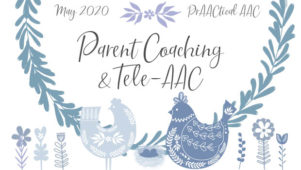5 Reasons to Put AAC Training for Staff and Parents into the IEP

SLPs tend to love (good, relevant) professional development. We flock to conferences (15,000+ ASHA attendees this past November), sign up for workshops, and attend webinars. But for some reason, we are reluctant to request training as part of the IEP process, even when we’re not very confident in our work with the student. Maybe we don’t want to acknowledge our need for it, or admit that there is something we don’t know (gasp!). Perhaps we’d just rather not make waves. We may ask for training informally, but it doesn’t always get tied to specific students’ IEPs, and that may mean that our requests get overlooked.
Here are a few reasons why you may want to put staff training into IEPs when needed.
-
We need it. The complexity of the AAC field, diversity of this clinical population, and the rapid pace of change in technology make it very unlikely that any one of us knows everything we need to in order to best serve individuals with AAC needs.
-
We deserve it. If there is information that you need to better serve the student, then, of course, you should have access to that. We sometimes devalue ourselves and fail to prioritize our own needs.
- It sends a message that AAC is important. When the IEP has a training component, someone has to think about, prepare for, schedule, and provide that training. And that sends a subtle message that AAC is important.
- Parents need the support. Let’s be honest: One thing most SLPs dream of is a caseload of AAC learners who use their SGDs or communication boards/books frequently during non-school hours. Without training families on how to use, maintain, and program the AAC system, how reasonable is it to expect the kind of carryover we hope for? For more on parent training under IDEA, see this article at WrightsLaw.
- It may not happen otherwise. In most places, there have been significant reductions in the amount of state/local AT and AAC trainings and fewer professionals are granted release time to attend them.
We all abhor device abandonment or underutilization. Training on AAC devices, apps, partner strategies, and intervention techniqes facilitate successful implementation (Johnson, 2008). If the IEP team thinks AAC is needed for a particular student, then surely they would agree that it should be implemented fully and well. Would anyone expect a teacher to implement SmartBoard technology or IEP software without some training? Well, maybe, but they shouldn’t. When a good evaluation is done and there are recommendations for specific AAC tools or strategies, we should assume that the team will need some training on how to implement those. And that includes the SLP who, contrary to popular belief, was neither taught this in grad school or is able to learn it all on her own in the evenings and weekends. The point is that training on how to implement AAC makes it more likely that it is successful. And that’s a pretty prAACtical idea.
:::::::::::::::::::::::::::::::::::::::::::::::::::::::::::::::::::::::::::::
Johnson, A.A., (2008) Factors Related to the REjection and/or Abandonment of AAC Devices. Doctoral dissertation, University of New Hampshire.
Filed under: PrAACtical Thinking
Tagged With: abandonment, IEP, parent training, Training
This post was written by Carole Zangari





6 Comments
Great article! We have been changing the way we deliver services in our school program so that there is more time to train staff and consult with teachers. We have a long way to go but I think we are headed in the right direction. Thanks for this info. I am going to share it with my “team.”
Amy, what a great idea! Would love to hear how this is working out for you and your team. 🙂
What kind of training for aac implementing would you recommend? Where would you find it?
Shelane, training topics would depend on what the needs of the learner looked like. In general, I tend to recommend training on a) some basic concepts in using the device (charging, safety, back-ups, etc), and b) strategies to help the communicator learn to use the SGD (e.g., aided language input, creating communication opportunities, providing supportive feedback, etc.). I tend not to recommend the kind of device-focused trainings that we did so much of in years past. I have no objective to it, but generally what people want most is to know how to help the child use it. Most of the info on tech stuff is available online these days, so I really focus more on the supporting the interaction and learning processes. In some cases, schools have staff who can provide that training. In others, they have to bring in an outside speaker.
Any links to IDEA Law that says Training is part of IDEA? thx
Liz, this might help: http://www.wrightslaw.com/advoc/articles/support.bardet.htm